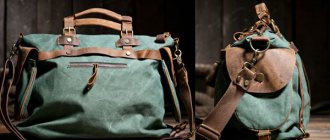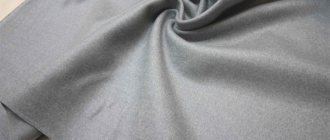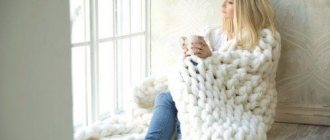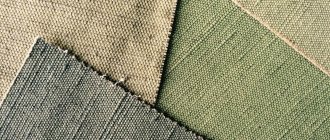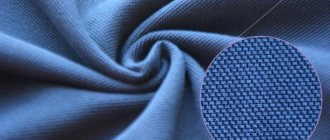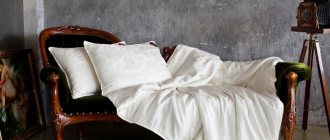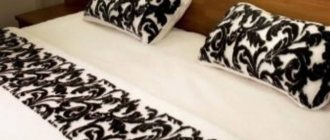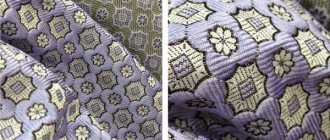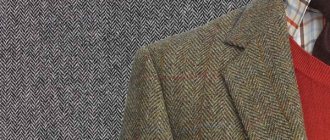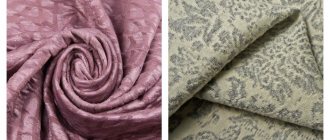What type of fabric is this?
Merino sheep are a breed of sheep that are bred for their wool. It consists of thin soft fibers, between which there are air cavities. Merino pile is 1.5-2 times thinner than that of ordinary breeds.
Various colors of merino fabric
Merino wool is not only very warm, but also durable. Unlike ordinary sheep's wool, it does not prick and does not irritate the skin.
Light and warm fabric is made from wool yarn. Its natural shade is white or light beige. Sometimes it is left to emphasize naturalness, in other cases it is painted.
Description
Merino wool - what is it and why is it so good? Sheep of this breed are distinguished by incredibly thin fleece. For comparison, human hair is several times thicker. The result is a material that is incredibly thin, delicate and smooth. It is several times softer than natural silk and five times more elastic than cotton.
You can see what merino is in our selection of photos.
Origin story
Wool has been known to mankind since ancient times. It is knitted, felted, woven. Clothes made of woolen cloth were already known in Ancient Rome.
The Merino sheep breed originated in Spain. It is believed that it originated from sheep brought from North Africa and Asia Minor. In the XII-XVI centuries. Spain was famous for its quality wool and even supplied it to England and Flanders.
Until the 18th century, exporting sheep from the country was prohibited, but later the breed spread throughout the world. Today, the leader in the production of merino wool is Australia (up to 80% of the world market). The material is produced in many European fabrics, Italian is especially popular.
Fabric composition and its properties
Merino wool is very fine (thinner than human hair), and there are tiny air cavities between the fibers.
This combination makes the fabric incredibly warm and soft. The fleece is covered with a natural lubricant - lanolin. Thanks to this, the material is durable and elastic.
Lanolin is credited with medicinal properties. Wearing merino items is recommended for arthritis, radiculitis, edema, bronchitis and bronchial asthma.
In addition to 100% merino, materials with various impurities :
- synthetic fibers reduce cost and increase resistance to aggressive influences;
- some artificial fibers add elasticity (elastane, lycra);
- the admixture of other types of wool (for example, alpaca) makes the fabric denser and stiffer;
- silk adds smoothness and shine.
A combination of several components is possible. For example, merino, alpaca and polyester. Or polyamide, merino wool and silk.
Types of fabric
Merino wool fabric varies in thickness, purpose and production features:
- gabardine is a durable material that is distinguished by its twill, or diagonal, weave of threads and water-repellent properties;
- flannel - soft, light and velvety, with double-sided brushing;
- stretch - with the addition of 2-5% elastane, fits the figure better and wrinkles less;
- knitwear is a soft fabric that makes clothes look informal;
- jersey - thick knitwear.
Types of Merino Fabric
Care instructions
Caring for products made from merino fabric is simple:
- The fabric can only be washed by hand. The water temperature for washing is selected depending on the manufacturer’s recommendations and is no more than 60 degrees;
- Products can be cleaned using special products. They resort to this infrequently, since the material has dirt-repellent properties. Cleaning needs to be done by special services;
- You cannot wring out the products! Dry flat on a soft surface, for example, a towel, in a well-ventilated area;
- pillows, rugs and blankets are not washed. They need to be immersed in water with detergent for a few minutes, taken out, allowed to drain and laid out to dry without twisting;
- To restore the color of an old product, just keep it in water with lemon juice added to it.
Pros and cons of fabric
Advantages:
- keeps warm;
- the fabric allows air to pass through, allowing the body to breathe under clothing;
- does not cause allergies;
- hygroscopic material (capable of absorbing moisture up to a third of the volume, so the body underneath remains dry);
- wool contains lanolin (animal wax), which is known for its restorative and anti-inflammatory properties;
- does not absorb odors (for example, sweat);
- pollution does not penetrate deep into the structure of six, but remains on the surface (things are easier to clean);
- Products made from merino wool last a long time if properly cared for;
- do not become electrified and do not stick to the body.
Flaws:
- difficult care;
- pellets appear;
- high price.
What kind of wool is there? Varieties
To obtain yarn, the pile is cut from the withers area. In this part the thickness is up to 20 microns. Curls form on the scruff of the sheep, which creates elasticity in the wool.
How yarn is marked:
- Strong – thickness 20 – 22.5 microns. Sometimes it reaches over 23 microns. Used in the production of machine knitting;
- Average diameter Medium - varies between 18 - 20. This type accounts for 14.6% of world production;
- Thin Fine – 16 – 17 microns. Market share 7%;
- Very thin thread with the designation Super Fine - 14 - 15 thickness. Wool, as light as feathers, is used to create expensive fabrics;
- Ultra-fine Extra Fine – diameter 12 – 13 microns. Due to its small population, it is considered a rare species. Sheep are walked in cloudy weather wearing special capes. It is possible to avoid tangling of fibers.
Magic properties, characteristics
Merino wool has good moisture absorption capacity, 30% of its own weight. It heats up to the temperature of the human body, absorbing water. This eliminates unpleasant sensations when coming into contact with the material. Bedspreads and clothes remain dry to the touch.
Suitable for sensitive skin. Does not cause allergic reactions, redness, or irritate it. Resilience, elasticity, and antimicrobial properties make it resistant to odor. Antistatic, fire-resistant features are the main advantages over synthetics. The creatine contained creates unfavorable conditions for the growth of bacteria.
Thermal insulation - air bubbles form inside the fibers, preventing the flow of cold from entering the body. For this reason, manufacturers fill sleep products with wool: mattresses, pillows.
Calming influence. Merino contains the substance lanolin, which softens the skin. In demand in cosmetology. Included in creams with a calming effect.
Self-cleaning - each thread has a core in the form of double cells that absorb moisture differently. If humidity increases, one fills with liquid, the second changes size. When they come into contact, friction occurs between them. Thanks to this property, the products do not require special care. Fresh air ventilation is recommended.
Electrostatic characteristics. Wool reduces positive ionization in the body, which depresses and causes illness in humans. Being a natural protein, it neutralizes toxic particles.
Merino is a special variety whose wool has long, fine fibers. Until now, scientists have not developed a breed that would be its analogue.
Warms, heals
Yarn has a healing effect on the entire human body:
- It has a beneficial effect on bones, joints, lumbar region, and improves blood circulation.
- The wax content has an anti-inflammatory effect. For people suffering from rheumatic diseases and bronchial asthma, it is necessary to wear wool clothing.
- Relieves fatigue and tension.
- Promotes good sleep, eliminates insomnia.
- Warms against colds and viral infections.
What are they sewing?
Manufacturers produce the following products based on merino wool:
- blankets, rugs;
- overalls, hats, tights;
- sweaters, turtlenecks, cardigans;
- thermal underwear: for athletes, daily wear;
- house shoes, insoles;
- outerwear;
- seat covers.
Merino blanket
The material is silky and smooth. The product is not susceptible to dust mites. To create a unique bedspread, the yarn is subjected to special processing:
- technical beating;
- manual sorting of fibers, removal of matted areas;
- painting taking into account technology;
- joining dyed threads into a composition;
- to achieve a homogeneous result, multiple carding;
- spinning.
Blanket sizes:
- children's version – 100 x 100
- one and a half – 150 x 200
- double – 170 x 220
- European - 200 x 220, 240
If you adhere to the rules of care, the blanket will retain its quality and shape for a long time. In hot weather it will protect against flies and insects. In winter it will keep you warm. Learn how to properly care for it:
- setting a delicate mode in an automatic machine;
- temperature regime no higher than 35 degrees;
- the use of aggressive chemicals and bleaches is prohibited;
- separate wash, without extraneous items;
- remove stains in warm water and laundry soap.
Thermal clothing
Linen made from merino wool is valued for its hygroscopicity and thermal characteristics. Can be worn on a naked body; no additional clothing items are required. Will warm you up during winter fishing, hunting, or outside in severe frost. The standard set includes a T-shirt and long johns. The assortment is complemented by socks, shorts, turtlenecks, and balaclavas. The advantages of the products are a wide range of temperature conditions for wearing, moisture absorption, and two-layer fabric.
slippers
Slippers are made from 100% wool. Stitched sole 8 mm, does not get wet, with anti-slip effect. Automatic washing is acceptable. Suitable for wearing in a private house or apartment. Warm the legs and provide dry warmth to the feet. They have a preventive effect, preventing diseases of rheumatism and fungus. They have no sweat smell. Everyday wearing of merino shoes reduces foot fatigue and improves blood circulation.
Pillows
Filling with sheep wool makes the pillow weightless. For those who like to sleep on a low, soft pillow, this is the ideal solution. During rest, the head is not in danger of hypothermia or overheating.
A wide selection of models presented in stores allows you to choose the right size. Designer design, taking into account your body type and preferences. Quilted covers are included.
What standards are used in production?
GOST 26383-84 defines the standards for merino wool.
Fine wool can be merino or crossbred. Moreover, the first one is soft, elastic and uniform, white in color. Merino wool is divided into classes according to thickness:
- 80ᴷ - from 14.5 microns
- 70ᴷ - 14.5-20.5 microns;
- 64-70ᴷ - 23-20.5 microns;
- 64-60ᴷ - 20.6-25 microns;
- 60ᴷ - 23.1-25 microns.
And according to the length of the fibers:
- I - from 70 mm;
- II - 55-70 mm;
- III - 40-55 mm;
- IV - less than 40 mm.
Watch the video about the production of merino wool:
Classification
Merino wool is classified according to a number of characteristics. It is important, no doubt, how much raw material each animal produces, but a much more important factor is how thin and strong the fiber is. It depends on the age and condition of the animal, the location of the cutting site.
Finished threads are also distinguished by the type of spinning.
By fiber thickness
The main characteristic of merino wool is the thickness of the fiber. It is defined in micrometers; modern standards imply that the count starts at 24 microns.
- Strong (24 – 21 µm);
- Medium (21 – 20 µm);
- Fine (20 – 18 µm);
- Superfine (18 – 16)
- Ultrafine or Extrafine (16 or less).
The highest class is Extra fine, this wool is usually cut from the withers of the youngest animals. There is a trend in the selection of sheep with even fewer microns.
By processing technique
Merino wool can be spun in different ways, and the final result will vary. From the harvested raw materials (washed, peeled, dried), the longest fibers are combed out using special machines with combs, selected from 3.5 cm and longer. They are used to spin yarns of the highest quality: combed merino is distinguished by increased tenderness, smoothness and amazing elegance.
If you combine extrafine fibers and combed spinning, you get premium yarn that does not prick, does not pill, and retains its original appearance for a very long time.
Carded technology differs from combed technology in that the raw material does not go through the combing stage, but is spun immediately after processing with carded drums. The resulting threads will be less strong, but more textured and fluffy. Many people prefer them because carded merino is cheaper and warmer.
What purposes can this fabric be used for?
Made from merino:
- suits, warm dresses and skirts;
- blouses and turtlenecks (from mixed fabrics);
- outerwear (coat, etc.);
- hats;
- thermal underwear;
- scarves;
- children's clothing (including for newborns);
- blankets and blankets that can keep you warm in winter;
- pillows with such filling, unlike synthetic ones, do not cause allergies.
Merino wool items
When is it better to use woolen underwear and when is it better to use synthetic underwear?
If the activity is low and the person only sweats slightly and briefly, then an excellent way to maintain comfort and warmth is to use woolen underwear, if there is no allergy to it. Wool will also prolong the feeling of cleanliness and freshness.
If the physical activity is intense and prolonged or the operation is associated with serious mechanical stress (rupture, abrasion), then it is better to use more unpretentious synthetics. Especially if the thermal underwear is part of a three-layer system, where the effectiveness of each layer depends not only on its own characteristics, but also on the proper combination of all layers.

